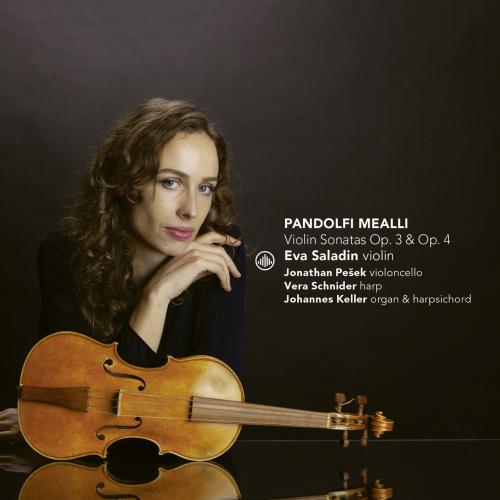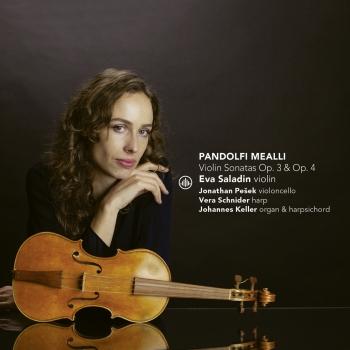
Pandolfi Mealli: Violin Sonatas Op. 3 & 4 Eva Saladin
Album info
Album-Release:
2023
HRA-Release:
25.07.2023
Label: Challenge Classics
Genre: Classical
Subgenre: Instrumental
Artist: Eva Saladin
Composer: Giovanni Antonio Pandolfi Mealli (1629-1679)
Album including Album cover Booklet (PDF)
- Giovanni Antonio Pandolfi Mealli (1630 - 1670): 6 Violin Sonatas, Op. 3:
- 1 Mealli: 6 Violin Sonatas, Op. 3: II. Sonata in A Minor "La Cesta" 07:55
- 2 Mealli: 6 Violin Sonatas, Op. 3: III. Sonata in D Major "La Melana" 05:36
- 3 Mealli: 6 Violin Sonatas, Op. 3: V. Sonata in E Minor "La Clemente" 08:08
- 6 Violin Sonatas, Op. 4:
- 4 Mealli: 6 Violin Sonatas, Op. 4: V. La Stella 04:31
- 5 Mealli: 6 Violin Sonatas, Op. 4: III. La Monella Romanesca 06:53
- 6 Violin Sonatas, Op. 3:
- 6 Mealli: 6 Violin Sonatas, Op. 3: VI. Sonata in C Major "La Sabbatina" 07:26
- 6 Violin Sonatas, Op. 4:
- 7 Mealli: 6 Violin Sonatas, Op. 4: II. La Viviana 05:47
- 8 Mealli: 6 Violin Sonatas, Op. 4: IV. La Biancuccia 08:12
- 6 Violin Sonatas, Op. 3:
- 9 Mealli: 6 Violin Sonatas, Op. 3: IV. Sonata in D Major "La Castella" 08:15
- 6 Violin Sonatas, Op. 4:
- 10 Mealli: 6 Violin Sonatas, Op. 4: I. La Bernabea 08:38
- 6 Violin Sonatas, Op. 3:
- 11 Mealli: 6 Violin Sonatas, Op. 3: I. Sonata in A Minor "La Stella" 04:04
- 6 Violin Sonatas, Op. 4:
- 12 Mealli: 6 Violin Sonatas, Op. 4: VI. La Vinciolina 06:01
Info for Pandolfi Mealli: Violin Sonatas Op. 3 & 4
Challenge Classics is proud to release the first disc of Baroque violinist Eva Saladin. For For her debut release on the Challenge Classics label, Eva Saladin has chosen the scantly known sonatas by Pandolfi Mealli, an apparently marginal figure in the richest violin landscape of the 17th century.
Born in 1624, Giovanni Antonio Pandolfi Mealli was brought up partly in Venice and ended up in Innsbruck as a member of the Court Band. His name crops up later as a violinist in churches and at court in Messina and finally in Madrid, where it is likely that he died in 1687. There were two important stylistic periods for violin literature in the 17th century. In the early decades, a corpus of instrumental music appeared in northern Italy, with the first solo music explicitly for violin being written by composers such as Castello, Fontana and - most of all - Marini. Towards the tail-end of the century, we see the flowering of a refined culture of instrumental music in Austria, dominated by virtuosi such as Biber, Walther and Schmelzer. Pandolfi Mealli was caught in the middle, not being a follower of either school, and may have been somewhat lost from view among all these star performers.
'The twelve sonatas included in this album were published in Innsbruck in 1660 as two volumes, opus numbers 3 and 4, and are generally considered to be a united pairing. At first sight, the sonatas offer little in the way of variety. Some older literature even voices disdain at these works because of their lack of individualist, virtuoso or violinistic elements.
'Closer inspection, however, reveals a good number of interesting features in the collection: each sonata seems to have its own pronounced and unique character, varying from the obsessively chromatic to the heavenly naive. We can see subtle differences between ostensibly similar movements and the music is full of unexpected twists and turns. Stylistically, some of the sonatas clearly refer to early-17th-century Venetian examples. Others introduce elements that would play an important part in later Austrian repertoire for violin. Many of the sonatas are surprisingly vocal, some sort of reference to contemporary song culture. These vocal sections invite the violin to decorate the melody.
'It is also hard to determine what instrumentation would have been used as the continuo for this repertoire. My own choice, based on the colourful combination of harp, organ and cello, is based in part on contemporary sources but also on my own curiosity about the tonal possibilities of this ensemble.' (Eva Saladin)
Eva Saladin, violin
Jonathan Pesek, cello
Vera Schnider, harp
Johannes Keller, organ & harpsichord
Eva Saladin
studied at bachelor and master levels on modern violin with Kees Koelmans and baroque violin with Lucy van Dael at the Amsterdam Conservatory. In 2013, she finished her master’s degree on baroque violin with Leila Schayegh at the Schola Cantorum Basiliensis. During her studies in Basel, she was a regular member of Rudolf Lutz ’s improvisation class.
She is currently living in Basel (Switzerland) as a freelance musician. She gives solo recitals and performs with various chamber music ensembles and orchestras with a repertoire from the early 17th up to the early 19th century, focusing on historical playing styles and technique, improvisation and embellishment.
Apart from her solo engagements, she is the leader of her own Ensemble Odyssee in Amsterdam, of La Cetra Barockorchester Basel and of Gli Angeli Gen ève. She regularly plays with groups such as Collegium Vocale Gent, Il Profondo, Profeti della Quinta, Il Gusto Barocco and Capricornus Ensemble Stuttgart. She is also active in the field of free improvisation and contemporary music theatre.
In 2021, she was Artist in Residence at the Utrecht Early Music Festival. She also plays at the Festival de Saintes, Festival Lanvellec, Barockfestspiele Bad Arolsen, Händelfestspiele Halle, Barockfestspiele Sanssouci, Thüringer Bachwochen, MA Festival Brugge, Les Nuits de Septembre, Festival de Verbier, York Early Music Festival, Crete Senesi and many others. She has recorded several CDs for various labels. Her first solo album “The Di Martinelli Manuscript” was issued by Glossa in 2021.
Booklet for Pandolfi Mealli: Violin Sonatas Op. 3 & 4












